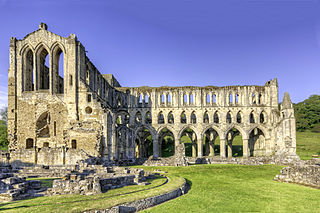
Rievaulx Abbey was a Cistercian abbey in Rievaulx, near Helmsley, in the North York Moors National Park, North Yorkshire, England. It was one of the great abbeys in England until it was seized in 1538 under Henry VIII during the Dissolution of the Monasteries. The wider site was awarded Scheduled Ancient Monument status in 1915 and the abbey was brought into the care of the then Ministry of Works in 1917. The ruins of its main buildings are today a tourist attraction, owned and maintained by English Heritage.

Gisborough Priory is a ruined Augustinian priory in Guisborough in the current borough of Redcar and Cleveland, North Yorkshire, England. It was founded in 1119 as the Priory of St Mary by the Norman feudal magnate Robert de Brus, also an ancestor of the Scottish king, Robert the Bruce. It became one of the richest monastic foundations in England with grants from the crown and bequests from de Brus, other nobles and gentry and local people of more modest means. Much of the Romanesque Norman priory was destroyed in a fire in 1289. It was rebuilt in the Gothic style on a grander scale over the following century. Its remains are regarded as among the finest surviving examples of early Gothic architecture in England.

Thornton Abbey was a medieval abbey located close to the small North Lincolnshire village of Thornton Curtis, near Ulceby, and directly south of Hull on the other side of the Humber estuary. Its ruins are a Grade I listed building, including notably England's largest and most impressive surviving monastic gatehouse.
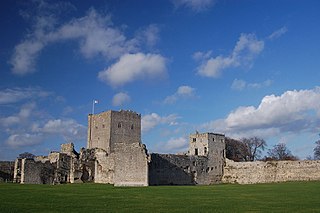
Portchester Castle is a medieval fortress that was developed within the walls of the Roman Saxon Shore fort of Portus Adurni at Portchester, to the east of Fareham in Hampshire.
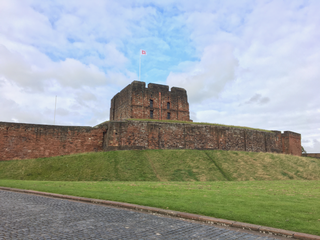
Carlisle Castle is a medieval stone keep castle located in the city of Carlisle near the ruins of Hadrian's Wall. First built during the reign of William II in 1092 and rebuilt in stone under Henry I in 1122, the castle is over 930 years old and has been the scene of many episodes in British history.

Sir Robert de Ros was an Anglo-Norman feudal baron, soldier and administrator who was one of the twenty-five barons appointed under clause 61 of the 1215 Magna Carta agreement to monitor its observance by King John of England.

Woodspring Priory is a former Augustinian priory. It is near the scenic limestone promontory of Sand Point and Middle Hope, owned by the National Trust, beside the Severn Estuary about 3 miles (5 km) north-east of Weston-super-Mare, within the English unitary authority of North Somerset. Many of the buildings are Grade I listed, and the whole site is scheduled as an ancient monument.

Helmsley Castle is a medieval castle situated in the market town of Helmsley, within the North York Moors National Park, North Yorkshire, England.

Upsall Castle is a fourteenth-century ruin, park and manor house in Upsall, in the Hambleton district of North Yorkshire, England.
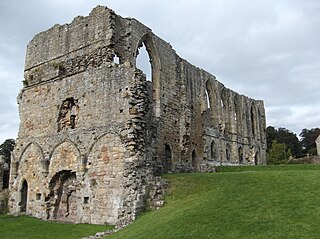
Easby Abbey, or the Abbey of St Agatha, is a ruined Premonstratensian abbey on the eastern bank of the River Swale on the outskirts of Richmond in the Richmondshire district of North Yorkshire, England. The site is privately owned but maintained by English Heritage and can be reached by a riverside walk from Richmond Castle. Within the precinct is the still-active parish church, displaying 13th-century wall paintings.
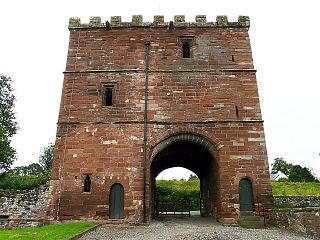
Wetheral Priory Gatehouse is a 15th-century stone fortification in Wetheral, Cumbria. The priory was founded at the start of the 12th century and the gatehouse controlled the entrance to its outer courtyard. When the priory was dissolved in 1538 the gatehouse and a nearby stretch of wall were the only parts to survive. The gatehouse passed into the control of Carlisle Cathedral and became the local vicarage during the 16th and 17th centuries, before being used to store hay. Now part of a modern farm that occupies the former priory site, it is controlled by English Heritage and open to visitors. The crenellated gatehouse has three storeys, with the main entrance and porters' lodge on the ground floor and two domestic chambers on the upper floors. English Heritage considers the building to be "the finest medieval gatehouse in Cumbria".

Thomas Dacre, 2nd Baron Dacre of Gilsland, KG was the son of Humphrey Dacre, 1st Baron Dacre of Gilsland and Mabel Parr, great-aunt of queen consort Catherine Parr, the sixth and final wife of King Henry VIII of England. His mother was the daughter of Sir Thomas Parr of Kendal by his wife, Alice Tunstall.
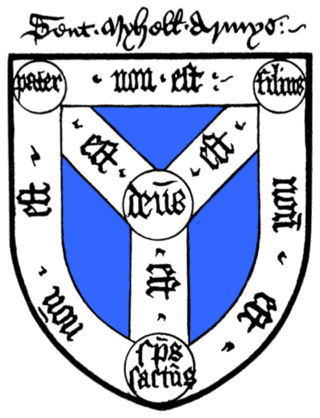
The Holy Trinity Priory, also known as Christchurch Aldgate, was a priory of Austin canons founded around 1108 by the English queen Matilda of Scotland near Aldgate in London.
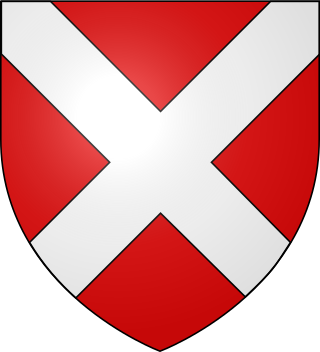
Ralph Neville, 2nd Baron Neville of Raby was an English aristocrat, the son of Ralph Neville, 1st Baron Neville de Raby by Eupheme de Clavering.
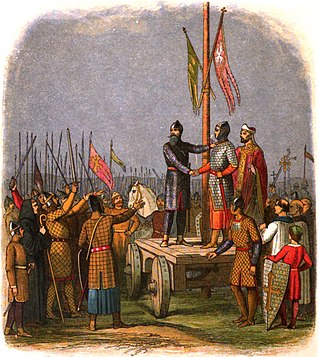
Walter Espec was a prominent military and judicial figure of the reign of Henry I of England.

Westow is a village and civil parish in the Ryedale district of the county of North Yorkshire, England. The village lies in the historic boundaries of the East Riding of Yorkshire. Westow is situated in the lee of Spy Hill, bordering the Howardian Hills Area of Outstanding Natural Beauty, 3 miles (4.8 km) from the A64 road linking Leeds to the East Coast, 5 miles (8 km) west of the town of Malton, and 15 miles (24 km) east of the city of York.

Pentney Priory was an Augustinian priory at Pentney in the district of King's Lynn and West Norfolk, Norfolk, England. The ruins of the priory, mostly comprising the flint-built gatehouse, are Grade I listed.

Pennsylvania Castle is a Gothic Revival mansion on the Isle of Portland, Dorset, England. It is located in Wakeham and overlooks Church Ope Cove. The castle is Grade II Listed, as is the adjacent gatehouse and lodges, which are now in separate ownership.

William Greystoke, 2nd Baron Greystoke, of Greystoke in Cumbria, was an English peer and landowner.

Sir John Speke (1442–1518) of Whitelackington, Somerset and of Heywood in the parish of Wembworthy and of Bramford Speke both in Devon, was Sheriff of Devon in 1517 and a Member of Parliament (1477). He was knighted in 1501. His monument is the Speke Chantry in Exeter Cathedral in which survives his recumbent effigy.
























